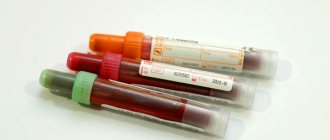Synonyms: determination of total IgE, immunoglobulin E, immunoglobulin E total, immunoglobulin class E, IgE, IgG total, Immunoglobulin E.
Related tests: allergy screening: inhalation, food, inhalation-food, pediatric panels, complete blood count.
Determination of total IgE is carried out to identify allergies. This indicator is also used as an additional method for differentiating atopic diseases with an allergic component among a variety of pathologies clinically manifested as asthma, frequent respiratory diseases, chronic rhinitis, dermatitis, chronic diarrhea and others.
The study is recommended for:
- Food allergies;
- Drug allergies;
- Allergies to pollen;
- Ascariasis;
- Intestinal nematode;
- Echinococcosis;
- Amoebiosis;
- Hookworm;
- Bronchial asthma;
- Rhinitis;
- Sinusitis;
- Dermatitis;
- Hives;
- Quincke's edema;
- High level of eosinophils;
- Allergic bronchopulmonary aspergillosis;
- IgE myeloma;
- DiGeorge syndrome;
- Nodular periarthritis;
- Wiskott-Aldrich syndrome;
- Jobe-Buckley syndrome;
- Neumann's syndrome.
Method:
Enzyme-linked immunosorbent assay (ELISA).
Sensitivity:
Not less than 2.5 IU/ml.
Material for research:
Blood serum.
Total immunoglobulins E (IgE) in human serum are gamma globulins produced by B lymphocytes. Their main function is participation in immediate (reagin) type reactions, as well as antiparasitic protection.
Synonyms Russian
Immunoglobulins class E.
English synonyms
Immunoglobulin E, IgE, total (serum).
Research method
Solid-phase chemiluminescent enzyme-linked immunosorbent assay (“sandwich” method).
Determination range: 0.1 - 50000 IU/ml.
Units
IU/ml (international unit per milliliter).
What biomaterial can be used for research?
Venous blood.
How to properly prepare for research?
- Do not eat for 2-3 hours before taking the test; you can drink clean still water.
- Avoid physical and emotional stress for 30 minutes before the test.
- Do not smoke for 3 hours before the test.
General information about the study
Human serum immunoglobulins (Ig, antibodies) are gamma globulins produced by beta lymphocytes. Their main function is the recognition and destruction of antigens. Immunoglobulins consist of 2 heavy (H) and 2 light (L) chains linked by disulfide bridges. Depending on the structure of the H-chains, they are divided into classes: G, M, A, D and E.
Class E immunoglobulins (reagins) are involved in the development of atopic allergic reactions (bronchial asthma, rhinitis, urticaria, atopic dermatitis, etc.). They are able to quickly attach to the surface of mast cells and basophils of the skin and mucous membranes. Therefore, repeated contact of reagin IgE with the antigen (allergen) occurs on the surface of these cells, which leads to the release of vasoactive substances from them (histamine, serotonin, heparin, etc.) and the development of clinical manifestations of type 1 hypersensitivity reaction.
75% of children whose parents suffer from allergic diseases have elevated IgE levels. Among healthy children, elevated levels of total IgE are associated with a 10-fold increase in the risk of developing allergic diseases over the next 18 months compared with children whose blood levels of total IgE are within normal limits. A test for total IgE in blood plasma is used as a screening to identify allergies, but to find the causative allergen, it is necessary to identify specific IgE.
In addition, IgE plays a significant role in the formation of antiparasitic immunity to roundworms, toxoplasma, nematodes, echinococci, trichinella and other parasites, which is due to the ability of IgE to interact with helminth antigens. Therefore, an increase in the level of total IgE in the blood plasma may indicate the presence of parasitic infestation.
What is the research used for?
- For diagnosing allergic diseases and assessing the effectiveness of their treatment.
- For diagnosis, in particular differential, of helminthic infestations.
- To assess the risk of developing allergic reactions in children.
- For the diagnosis of certain immunopathological diseases.
When is the study scheduled?
- If IgE myeloma or other immunopathological diseases are suspected.
- For symptoms of bronchopulmonary aspergillosis.
- For children – when their parents suffer from allergic diseases.
- If a helminthic infestation is suspected.
What do the results mean?
Reference values
| Age | Reference values |
| Newborns | 0 - 1.5 IU/ml |
| Less than 1 year | 0 – 15 IU/ml |
| 1-6 years | 0 – 60 IU/ml |
| 6-10 years | 0 – 90 IU/ml |
| 10-16 years | 0 – 200 IU/ml |
| More than 16 years | 0 - 100 IU/ml |
Reasons for increased levels of total IgE
- Parasitic infestations (ascariasis, intestinal nematodosis, echinococcosis, hookworm disease, amoebiasis, helminth larval migration syndrome).
- Allergic bronchopulmonary aspergillosis.
- Allergic diseases caused by IgE antibodies: atopic (atopic bronchial asthma, allergic rhinitis and sinusitis, atopic dermatitis, drug and food allergies) and anaphylactic (anaphylaxis, urticaria, angioedema).
- Immunopathological diseases (IgE myeloma, periarteritis nodosa, hypereosinophilia syndrome, dysplasia and aplasia of the thymus (DiGeorge syndrome), Wiskott-Aldrich syndrome, hyper-IgE syndrome and recurrent pyoderma (Job-Buckley syndrome), pemphigus (Neumann syndrome), reaction "graft versus host".
Reasons for reducing the level of total IgE
- Hereditary, sex-linked or acquired hypogamma-globulinemia.
- Ataxia-telangiectasia.
- Primary or secondary immunodeficiencies.
2.Why is this done?
A blood test for immunoglobulin is done in order to:
- Find a specific allergy or autoimmune disease;
- Find certain types of cancer (multiple myeloma or macroglobulinemia);
- Determine whether relapse of diseases is the result of low immunoglobulin levels;
- Check the progress of treatment for bone marrow cancer;
- Check the progress of treatment for the bacterium helicobacter pylori;
- Check the immunization process;
- Check to see if you have or have had an infection before.
An immunoglobulin test is performed when the electrophoresis or total blood protein test results are abnormal.
What type of hypersensitivity to allergens is the most dangerous?
As Kuzma Prutkov said: “Look at the root.” And in this situation, the root of the pathogenesis of allergic reactions will be the release of an increased amount of cellular mediators, those that will already realize the clinical picture of the allergy. And in this situation, only a doctor can help you figure it out. What type of allergic reaction are you experiencing? Because the approaches to the management and treatment of such patients will be completely different, and to diagnosis too. Each type of hypersensitivity has its own pathogenesis. The only thing is that in the implementation of hypersensitivity of the first type, allergens such as protein and pollen most often play an important role, and the same seasonal fever can be associated specifically with hypersensitivity of the first type. Also, some drugs, organic, inorganic, and chemical substances can cause anaphylactic reactions or type 1 hypersensitivity.
Why do I want to dwell in more detail on type 1 hypersensitivity? Because, from the point of view of a threat to human life, type 1 hypersensitivity can develop in a split second. It is more important and more dangerous, therefore, in order to correctly find out what kind of hypersensitivity you have, how to correctly approach certain aspects of treatment, of course, it is best, in this situation, to consult a doctor, a specialist who would definitely tell you established a diagnosis and selected the right treatment for you. And I categorically do not recommend self-medication.
In what pathologies is total immunoglobulin (IgE) elevated?
An increased level of total immunoglobulin E may indicate that the patient has hypersensitivity to most of the known allergens. In children, total immunoglobulin E (IgE) may increase due to hereditary pathologies, for example, dermatitis or asthma. In addition, an increase in the level of this protein in the blood may be due to the presence of the following diseases in the body:
- helminthiases;
- infectious mononucleosis;
- liver cirrhosis of alcoholic origin;
- immunodeficiency;
- parasitic diseases;
- autoimmune pathologies;
- hereditary predisposition.
4.What are the risks and what could interfere with the analysis?
What are the risks of an antibody blood test?
If you take a blood test for antibodies, then possible risks may be associated only with blood sampling. In particular, the appearance of bruises at the site of blood sampling and inflammation of a vein or artery (phlebitis). Warm compresses several times a day will relieve phlebitis. If you are taking blood thinning medications, you may bleed at the puncture site.
What can interfere with an immunoglobulin test?
A blood test for immunoglobulin may be useless for the following reasons:
- Taking certain medications. Tell your doctor about all the medications you are taking;
- Treating cancer with chemotherapy or radiation therapy;
- Blood transfusion six months ago or less;
- Vaccination, especially repeated vaccination;
- Alcohol or other intoxication;
- Radiation examination three days before the test.
Elevated levels of immunoglobulin IgE: methods of normalization
IgE immunoglobulin levels are a marker of immune health. A low or high level does not necessarily indicate a problem if there are no symptoms or if your doctor says there is nothing to worry about. Increasing your IgE levels will not necessarily improve your immune balance, but it can be used as a biomarker to assess your immune health.
Below is a list of additional approaches to improve immune health that can also balance high IgE levels. Although research suggests that various dietary and lifestyle factors can reduce IgE values, more large-scale studies are needed.
Be sure to talk to your doctor before making any major changes to your daily life.
Medications
Your doctor may prescribe immunologic medications to manage your high IgE levels. Treatment will depend on the underlying condition and your general symptoms.
For example, you may receive an inhaled medication for asthma, creams for eczema, or nasal sprays for hay fever.
These drugs may contain corticosteroids
(to reduce swelling),
antihistamines
(to block inflammation caused by histamine), or
decongestants
(to relieve nasal congestion). ()
There are drugs aimed at reducing immunoglobulin IgE
- Omalizumab
, a biological drug containing
anti-IgE antibodies
. They bind to IgE and remove it from the bloodstream, thereby reducing the allergic reaction. The US Food and Drug Administration (FDA) has approved this medication for the treatment of asthma and chronic hives. (, ) - Nedocromil sodium
and
disodium cromoglycate
(cromolyn sodium), which belong to a group of drugs called mast cell stabilizers. They come in the form of inhalers, nasal sprays and eye drops to treat asthma and seasonal allergies. (, , )
Avoiding allergens
If you are allergic to a certain food or animal, avoiding them will help prevent allergic reactions. You can also clean your home and workspace regularly to get rid of dust mites or mold.
Abstinence from smoking and drinking alcohol
Research shows a clear connection between smoking and high levels of immunoglobulin IgE. The same goes for drinking alcohol, even in moderation.(, , , )
Abstaining from smoking and drinking alcohol will help improve your immunity and your overall well-being.
Increasing the amount of vitamin E in the diet
Foods high in vitamin E can ease allergic reactions and also reduce IgE levels. Include a variety of vitamin E-rich foods in your diet.
Some foods high in vitamin E
- Sunflower seeds
- Almond
- Hazelnut
- Spinach
- Broccoli
- Avocado (, 88, )
DIAGRAM OF THE POSITIVE INFLUENCE OF QUAIL EGG ON REDUCING ALLERGIES AND REDUCING INFLAMMATION IN FOOD ALLERGIES (source)
Additional substances
Probiotic strain of bacteria Bifidobacterium longum
able to reduce IgE levels and fight allergic reactions (from numerous studies in mice and cells) (, , , )
Other strains of bacteria that may help include B. breve, L. plantarum and L. crispatus. (, , )
In addition to probiotics, certain supplements can support the immune system and also reduce the overproduction of immunoglobulin IgE:
- Vitamin E (, )
- Fish fat (, )
- Flavonoids (luteolin, apigenin, narirutin/naringenin) (100, 101)
More research is needed to confirm the beneficial effects of these supplements on the immune system. Consult your doctor before taking these substances.
Preparing for analysis
The biomaterial for the study is venous blood, which is taken from the ulnar vein in adults or the umbilical vein in newborns.
- Blood is drawn in the morning, when the IgE concentration reaches its peak;
- Blood must be donated on an empty stomach (at least 8-10 hours must pass after the last meal);
- On the day of the examination (immediately before the procedure), you can drink only plain water without gas;
- 2-3 hours before venipuncture, you should not smoke and/or use nicotine replacement products (chewing gum, spray, patch);
- The day before and on the day of blood sampling, the consumption of alcoholic beverages, drugs, and energy drinks is prohibited;
- Before the analysis, it is advisable to protect yourself from physical exertion and emotional stress.
Important! An immunological study is carried out 2 weeks after discontinuation of any medications or before the start of treatment. An IgE test is not prescribed during or immediately after physiotherapeutic procedures and other types of diagnostics (MRI, CT, radiography, etc.).
Other tests to assess immunity
- Immunoglobulin IgA
- Immunoglobulin IgG
- Immunoglobulin IgM
- Interleukins 1, 6, 8, 10
- TNF (tumor necrosis factor)
Indications
Only a specialist (immunologist, allergist, general practitioner, pediatrician, etc.) can interpret the results. When diagnosing, the general clinical picture of the disease, features of the allergy history, etc. are important.
- Assessment of the risk of developing allergies in children (in this case, the concentration of immunoglobulin is considered as a prognostic indicator);
- Study and assessment of the state of the immune system as a whole;
- Diagnosis of helminthic infestations;
- Differential diagnosis of all allergic reactions with similar symptoms;
- Selection of treatment tactics for pulmonary aspergillosis (pathology caused by a moldy fungus of the genus Aspergillus);
- Monitoring the effectiveness of treatment of allergic diseases and symptom complexes;
- Diagnosis of certain conditions associated with immunodeficiency;
- Determination of the type and degree of sensitization to a specific allergen.
References
- Godwin, L., Crane, J. Biochemistry, ImmunoglobulinE (IgE). StatPearls Publishing, 2021.
- MAYO Clinic Laboratories : website / Test ID: IGE Immunoglobulin E (IgE), Serum, 2021.
- Derya, U., Gelincik, A., Elitok, A. et al. Impact of high serum Immunoglobulin E levels on the risk of atherosclerosis in humans. AsiaPacAllergy, 2021. - Vol. 7(2). — P. 74-81.
- Joshi, A., Iyer, V., Boyce, T. et al. Elevated serum immunoglobulin E (IgE): when to suspect hyper-IgE syndrome-A 10-year pediatric tertiary care center experience. AllergyAsthmaProc., 2009. - Vol. 30(1). — P. 23-27.
- American Academy of allergy asthma and immunology: website / AAAAI, 2021. - URL: https://www.aaaai.org/ (accessed March 15, 2021).
Effect of antihistamines
Next comes the connection of histamine with receptors in target organs and we already see the clinical manifestation of the allergy itself. Each of us has heard of antiallergic drugs or antihistamines. How do they work? They block these receptors, and the clinical picture does not manifest itself violently. But then there is a question mark. Did this cause less histamine in the blood? Of course not. Have mast cells calmed down? Of course not. Therefore, when taking antihistamines, we must understand perfectly well that in terms of managing the pathogenesis and development of the entire allergic reaction, this is the most distant consequence. We eliminate the clinical picture. I am often asked: “So, shouldn’t I take it?” Take when the allergy is already actively manifesting itself. It is in such cases that antihistamines are needed. There are a huge number of them today. I won’t voice them all, give them characteristics, much less assign them and say which ones are better and which ones are worse, because they must be selected absolutely individually.
Immunoglobulin E (Ig E) general - diagnosis of allergic conditions
Material for research: blood serum.
Research method: IECHL.
Execution time: 1 working day.
Blood collection for general Immunoglobulin E (Ig E) is performed at all BRIGHT-Bio points.
Determination of the content of total Ig E in blood serum is used to diagnose atopic allergic diseases.
Preparation for the study: blood is taken on an empty stomach. At least 8 hours (preferably 12 hours) must pass between the last meal and the test. Juice, tea, coffee (especially with sugar) are not allowed. You can drink water.
The half-life of immunoglobulin class E ( Ig E) is 3 days in blood serum, and 14 days on the membranes of mast cells and basophils. The mechanism of atopic allergic reactions is closely related to immunoglobulins E. They have the ability to quickly fix on skin cells, mucous membranes, mast cells and basophils, therefore free Ig E is present in the blood plasma in small quantities. In addition to participating in type 1 allergic reactions , Ig E also takes part in protective anthelminthic immunity, which is due to the existence of cross-linking between Ig E and the helminth antigen.
Elevated Ig E in children with allergies and hypersensitivity to a large number of allergens are detected more often than in children with hypersensitivity to a small number of allergens, as well as in children whose target organs are not involved in the allergic process. Ig E levels in sick children with hypersensitivity to food and pollen allergens is higher than in children with hypersensitivity to house dust and mold.
In adults, determining the level of Ig E has less diagnostic value than in children. Elevated levels of Ig E are detected only in 60% of patients suffering from atopic bronchial asthma. The highest values of Ig E in the blood are observed with hypersensitivity to a large number of allergens in combination with asthma, dermatitis and rhinitis. With hypersensitivity to one allergen, the level of total Ig E may be within normal limits.
Allergic bronchopulmonary aspergillosis is accompanied by a significant increase in the level of Ig E in the blood. Its concentration is increased in almost every patient with allergic aspergillosis during the period of pulmonary infiltration.
Ig E level in patients with active lung disease excludes the diagnosis of aspergillosis.
When assessing the results of determining total Ig E , it should be borne in mind that in approximately 30% of patients with atopic diseases, the level of this immunoglobulin may be within normal limits.
When diagnosing an allergy, it is not enough to note an increase in total Ig E in the blood. Ig E antibodies against it.
Since the beginning of 2011, the BRIGHT-Bio laboratory has been determining allergen-specific Ig E in blood serum to various allergens grouped in panels.
- Allergy panel Polycheck Pediatric No1 (APPd1)
BRIGHT-Bio is making efforts to expand the list of Allergy panels.
The detection of allergen-specific Ig E (to any allergen or antigen) does not yet prove that this particular allergen is responsible for the clinical symptoms. The final conclusion and interpretation of the results should be made only after comparison with the clinical picture and allergy history data. The absence of specific Ig E in the blood serum does not exclude the possibility of participation in the pathogenesis of the disease Ig E -dependent mechanism, since local synthesis of Ig E and sensitization of mast cells can occur in the absence of specific Ig E in the bloodstream (for example, with allergic rhinitis).









